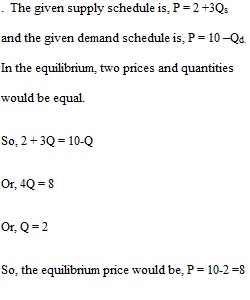


Q 1. Assume the following: a. The supply schedule is given from P = 2 + 3Qs b. The demand schedule is given from P= 10 - Qd Find the equilibrium price & the equilibrium quantity. Draw a diagram to account for equilibrium price, equilibrium quantity, slope, etc. 2. Evaluate the following statements using graphical analysis. Provide a brief narrative explanation of your graph to support your evaluation. Make sure the axes and curves in your graphs are properly labeled. a. “When demand for home heating oil increases, a shortage of heating oil will occur.” b. “A decrease in the supply of random access memory (RAM) chips for personal computers causes a shortage of RAM chips.” 3. Several economics faculty members were standing in line in the student union cafeteria for lunch. One was heard to say, “I sure wish the union would raise their food prices.” The others agreed. What in the world would motivate such a wish? 4. Rising jet fuel prices recently led most major U.S. airlines to raise fares by approximately 15 percent. Explain how this substantial increase in airfares would affect the following a. The demand for air travel. b. The demand for hotels. c. The demand for rental cars. d. The supply of overnight mail. 5. Visualize algebraically and diagrammatically the following: complementary goods, substitute goods, normal goods, and inferior goods. 6. Can information asymmetry be used for demand and supply applications??? (Use also examples derived from the health sector). 7. Familiarize yourselves with the “market for lemons.” (Use also examples derived from the health sector). 8. What are Giffen Goods? What are Veblen Goods? Do they defy the law of demand? Explain. 9. What are the “snob” and “bandwagon” effects? 10. Ponder the following: Has recent economic analysis changed to account for the human element? How? Explain. Has behavioral economics and cognitive economic analysis impacted our understanding of economics?
View Related Questions